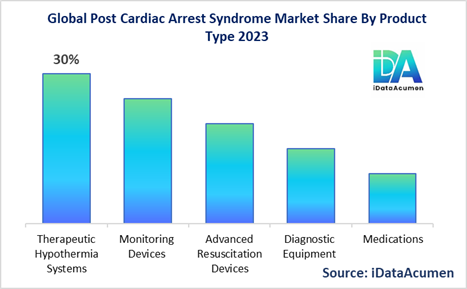Global Post Cardiac Arrest Syndrome Market is expected to reach US$ 3.0 Bn by 2031, expanding at a CAGR of 6.7% during the forecast period.
Post-cardiac arrest syndrome refers to a set of pathophysiological processes that occur after successful resuscitation from cardiac arrest. The syndrome comprises systemic ischemia/reperfusion response, brain injury, myocardial dysfunction, and persistent precipitating pathology. Post-cardiac arrest syndrome is a major cause of mortality and morbidity in patients who achieve return of spontaneous circulation after cardiac arrest.
The global post-cardiac arrest syndrome market is primarily driven by the rising prevalence of cardiovascular diseases globally coupled with increasing incidence of sudden cardiac arrests. According to the American Heart Association estimates, around 356,500 out-of-hospital cardiac arrests (OHCA) occur in the US every year. As the prevalence of risk factors like obesity, diabetes, hypertension rises, the incidence of OHCA is also expected to increase, in turn expanding the patient pool for post-cardiac arrest treatments.
Technological advancements in emergency medical services such as improvements in emergency response times, availability of AEDs, development of standardized protocols and initiation of public access defibrillation programs have improved OHCA survival rates in recent years. This has increased the hospitalizations for post-resuscitation care. Additionally, significant research and investments by public and private players to improve cardiac arrest outcomes through novel diagnostic and therapeutic approaches also support market growth.
Post Cardiac Arrest Syndrome (PCAS) is a condition that occurs after successful resuscitation from cardiac arrest. It is characterized by brain injury, myocardial dysfunction, systemic ischemia/reperfusion response and persistent precipitating pathology. PCAS is a major cause of mortality and morbidity in patients who initially achieve return of spontaneous circulation (ROSC) after cardiac arrest.

Drivers:
- Rising geriatric population coupled with increasing burden of cardiovascular diseases is significantly driving the incidence of sudden cardiac arrests globally. This creates demand for post-resuscitation therapies.
- Advances in extracorporeal life support technologies such as ECMO and therapeutic hypothermia systems are enabling better management of post-cardiac arrest syndrome.
Trends:
- Use of cerebral oximetry monitoring is gaining traction for neurological monitoring and guiding targeted temperature management in post-cardiac arrest patients.
- Research on neuroprotective pharmaceuticals to improve neurological outcomes post-resuscitation is rising.
Opportunity:
Emerging approaches such as ECPR, remote ischemic conditioning, biomarkers and wearable defibrillators hold significant potential for management of post-cardiac arrest syndrome.
Key Report Insights:
- Major market driver: Rising incidence of cardiovascular diseases and out of hospital cardiac arrests is driving the demand for better post-resuscitation care (Statistics show over 350,000 out of hospital cardiac arrests occur annually in the US).
- Companies are focusing on developing new therapies like therapeutic hypothermia, novel pharmaceuticals, and advanced monitoring devices to improve post-resuscitation care. For example, Bardy Diagnostics recently got FDA clearance for its Carnation Ambulatory Monitor for better arrhythmia monitoring in post-cardiac arrest patients.
- Advances in EMS services and availability of AEDs has improved cardiac arrest survival rates, in turn increasing the patient pool for post-resuscitation care.
- Shift towards personalized medicine and targeted temperature management is an important trend in the market.
Key Regional Insights:
- North America dominated the global post-cardiac arrest syndrome market with a share of 40.5% in 2023. Presence of key players such as Zoll Medical, Stryker, Physio-Control, and Baxter coupled with high incidence of cardiac arrests drive regional growth.
- Europe accounted for the second largest share of 32.2% in 2023, driven by rising burden of CVDs and government funding for advancing emergency medical services. Major companies include Koninklijke Philips, Bardy Diagnostics, Schiller.
- Prominent companies operating in the global market include Medtronic, Nihon Kohden, General Electric, Asahi Kasei, and Bardy Diagnostics among others. Significant R&D investments by these players to develop novel therapies and diagnostics solutions supports market growth.
Market Segmentation:
- By Product Type
- Therapeutic Hypothermia Systems
- Monitoring Devices
- Advanced Resuscitation Devices
- Diagnostic Equipment
- Medications
- By End-User
- Hospitals
- Emergency Medical Services
- Ambulatory Surgical Centers
- Trauma Centers
- Long Term Care Centers
- By Application
- Ventricular Fibrillation
- Asystole
- Pulseless Electrical Activity
- Others
- By Patient Group
- Adults
- Pediatric
- Geriatric
- By Regions
- North America
- Europe
- Asia Pacific
- Latin America
- Middle East & Africa
Definition:
“Post-cardiac arrest syndrome refers to a set of pathophysiological processes that occur after successful resuscitation from cardiac arrest. It comprises brain injury, myocardial dysfunction, systemic ischemia/reperfusion response and persistent precipitating pathology. The syndrome is a major cause of mortality and morbidity in patients who achieve return of spontaneous circulation after cardiac arrest. Post-cardiac arrest syndrome management involves treatments to stabilize cardiovascular function and mitigate neurological damage."